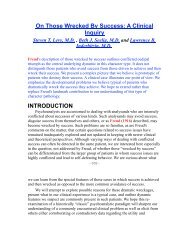A Sadomasochistic Transference - Beth J. Seelig, MD
A Sadomasochistic Transference - Beth J. Seelig, MD
A Sadomasochistic Transference - Beth J. Seelig, MD
Create successful ePaper yourself
Turn your PDF publications into a flip-book with our unique Google optimized e-Paper software.
y Kernberg, 1984) that had not been apparent in the initial evaluation—so much<br />
so that at times we questioned the validity of the initial neurotic diagnosis. It was<br />
only after some of the intense pregenital material was worked through in the<br />
transference that Miss T. presented a more classically neurotic picture, at which<br />
time the familiar oedipal dynamics manifest in the evaluative consultations could<br />
be productively analyzed.<br />
A slender, attractive, slightly boyish-looking twenty-two-year-old college<br />
senior who was living with her boyfriend, E., Miss T. began analysis to "resolve<br />
conflicts which I have about myself." When asked to elaborate, she went on to say,<br />
"I am not sure what I want to do careerwise and I feel that I am afraid to live up to<br />
my full potential."<br />
Her problems, as she experienced them, first manifested themselves in college<br />
in academic underachievement, in her inability to commit to a course of study<br />
commensurate with her gifts, and in increasing anxiety. In part this anxiety was<br />
said to<br />
- 967 -<br />
have been alleviated by her love relationship with E., a relationship presented as a<br />
mutually rewarding one, based on concordant interests and satisfying sex. She<br />
reported that she had close and enduring friendships and a variety of interests. Her<br />
ongoing problems seemed to be restricted to her academic life, where her<br />
performance had been hampered by such severe anxiety that her whole experience<br />
of college was "painful."<br />
Miss T. was a middle child with two older sisters and a younger brother, and<br />
she had always felt like the "superfluous girl." Her father was a social worker who<br />
worked long hours and her mother was a chronically depressed housewife, a<br />
highly intelligent woman whom Miss T. saw as having sacrificed her own<br />
ambitions to live in her husband's shadow.<br />
Miss T.'s relationship with her mother was tempestuous, both close and<br />
argumentative, but she felt remote from her intellectual, authoritarian father. She<br />
was described in her family as the embodiment of the little girl in the nursery<br />
rhyme who "When she was good … was very, very good, but when she was bad<br />
… was horrid." Painfully envious of all her siblings, she felt she was the only one<br />
who did not have a special place in the family. Miss T. reported that her two older<br />
sisters were valued because they were very beautiful, but as the not especially<br />
attractive third sister, she felt that she was little more than the byproduct of her<br />
parents' efforts to have a son. Nonetheless she described an uneventful<br />
developmental course, with the ability to function well both socially and<br />
academically. But her envy of her siblings, especially of her brother, continued




